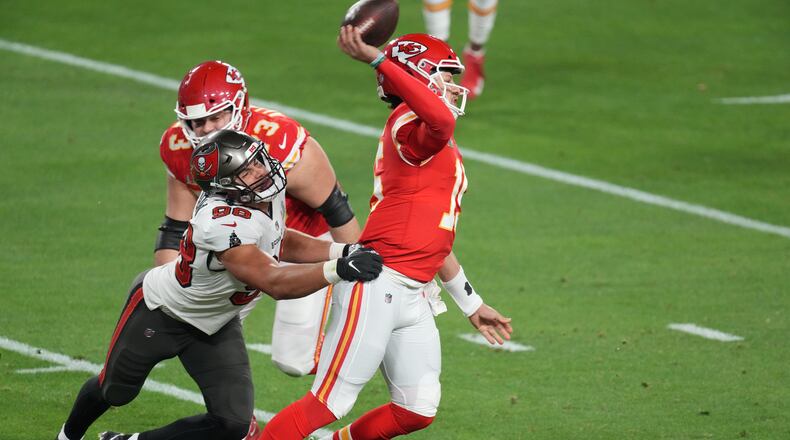(II) Pressure Without Blitzing
— Next Gen Stats (@NextGenStats) February 8, 2021
The Bucs blitzed on 9.6% of dropbacks, the LOWEST rate by a Bowles-led defense over the last five seasons.
🔹 4-Man Rush: 16 pressures, 34.0% QBP rate
*Bowles' three lowest blitz rates have all come against Andy Reid#SBLV | #GoBucs
- Since the deficiency of the Bengals offensive line is already a well-worn topic, the more important lesson is there is really no substitute for having a dominant defensive line (not to mention a proven defensive coordinator). Tampa’s Todd Bowles has gotten a lot of praise and rightly so. He not only devised a scheme to limit big passing plays for the Chiefs but had the wisdom and the discipline to let his front four take care of business up front (while helping them with stunts but not supplementing them with extra rushers and taking someone out of coverage). That is a defensive coordinators dream, especially in today’s football, but many coaches are still tempted to get too cute.
- The Buccs’ pass rushers also dominated the NFC championship game against Aaron Rodgers and the Packers, further driving home the point the Bengals must seriously improve on the defensive front — and I don’t think that’s solely about talent.
- There’s been lots of talk about the need to upgrade at linebacker (they do) and corner (since drafting Jesse Bates and signing Vonn Bell finally gave them a reliable pair of safeties), but the biggest disappointment of the Taylor era has been the front four. The talent to output ratio there has been stunningly bad considering some of the players on that unit, both young and old. It’s much more talented than the offensive line and has arguably performed worse in defensive coordinator Lou Anarumo’s schemes.
- The NFL couldn’t got a whole season without some officiating controversy. In this case, a couple of unnecessary flags on the Chiefs secondary helped Tom Brady and the Buccs seize control of the game in the second quarter. I’ve gone on record as believing the NFL’s pass defense rules (ironically stiffened because Brady’s early Patriots teams relied heavily on beating up Peyton Manning’s Colts receivers on their way to Super Bowls in the early 2000s) are too strict and really take away from the viewing experience, but I hadn’t felt that way as often this season.
- Ironically, one of the first notes I made about the Tampa defense early in the game was, “Maybe Ohio State should have blitzed this much against Alabama,” but then Bowles backed off the pressure and Patrick Mahomes was consistently running for his life anyway.
- Speaking of Ohio State — yes, Urban Meyer should have offered Antoine Winfield Jr.
— PFF (@PFF) February 8, 2021
- OK, OK, that was a little self-indulgent, but you know we can’t go too far without finding a Buckeye angle, right (and there was pretty much nothing else Ohio State-related in that Super Bowl)? Watching the younger Winfield make some of the same great instinctual plays his father made for the Scarlet and Gray will probably always hit a nerve.
- Here’s something more relevant for the present since since that’s long in the past: The pass rush might also have been Ohio State’s biggest downfall this season. Corners are gonna get beat, so pass rushers have to get home. The scheme the Buckeyes run is still heavily dependent on getting pressure with four, and that is something they have traditionally done with outstanding performers like Chase Young and the Bosa brothers, among others. It was less reliable this year, and that exacerbated the downgrade in play at cornerback. As with the Bengals, this is something of a matter of expectations. There seems to be more untapped potential up front than in the secondary with both teams, so the performance is more disappointing.
- The Super Bowl and the National Championship Game both offered more proof a team can’t win without a great passing game these days, but the threat of running (and sometimes actually running) remains essential. Tampa’s game-plan invited Kansas City to throw it every play, and the Chiefs obliged despite Clyde Edwards-Helaire averaging 7.1 yards per carry. The Buccs, who barely ran at all in the regular season, then used talented backs Leonard Fournette and Ronald Jones II to shorten the game in the second half, but some of Brady’s efficiency can also be traced back to Kansas City’s desire not to be run to death earlier in the game. The same can be said of the Alabama passing game, which took advantage of Ohio State choosing that poison over stud Crimson Tide running back Najee Harris running for 200 yards.
- A long-time knock on Andy Reid is he tends to abandon the running game too quickly, and that happened again Sunday night. Yeah you want a guy like Mahomes to have as many chances as he can to make something happen, but sometimes discretion is the better part of valor — especially when his tackles don’t have a prayer. The second half was cringeworthy at times watching him try to avoid getting splattered and just hoping his 2020 season wouldn’t end like Burrow’s did.
About the Author

